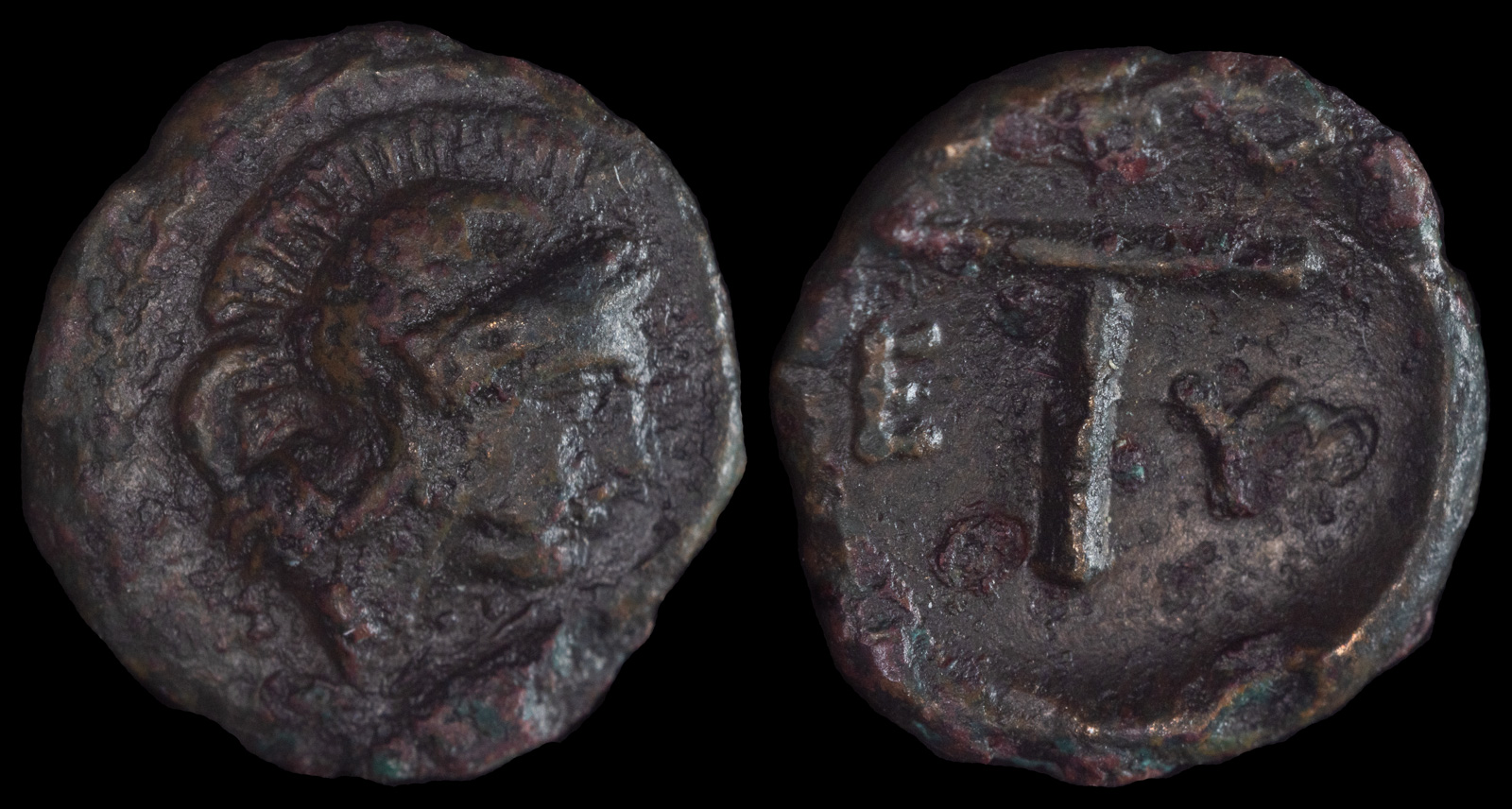
Lucania, Thurium
425-400 BCE
Æ 11.21mm 0.72g
Obverse: Head of Athena right wearing crested helmet
Reverse: ΘOYP above large T flanked by E-Y
Unpublished? SNG Cop–, BMC–, SNG Munich–, SNG Fitz–, SNG ANS–
Ex Athena Munzen der Antike Munich
This coin was sold as Thurium/Thourion (depending on the spelling you prefer) and I see no reason to dispute that. The city name appears on the top of the reverse and (interestingly) diagonally across the reverse in what appears to be an overstrike. That seems odd to me, since the overstrikes I’ve seen on bronze coins were for much larger denominations. It wouldn’t seem to be worth the effort on a tiny coin like this.
The large ‘T’ I believe stands for ‘Tetartemorion’, or 1/4 of an obol or 1/24th of a drachm. A number of cities produced small coinage with such a mark to indicate value. My belief is these were among the first bronze coins minted for these cities, and the mark indicated to people that they should be utilized over the far smaller silver coins that must have been a pain to manage. Since the denomination was small, I expect people would have been more willing to accept this substitution despite the far lower value of the metal.
In terms of a date range for the coin, the seller listed 350-300 BCE. However, I believe it’s a bit older. The E-Y flanking the ‘T’ was also used on Thourion’s silver coinage, such as this one. I have not read the research dating that coin, but all listings give a date of 443-400 BCE. Given the similar obverse of Athena and the identical lettering, I’m inclined to date my coin to roughly the same period, though I expect it was during the latter part of that range.
What catches me the most, though, is the counterstrike. Was there an earlier attempt with the city name diagonal to the coin? I found no such coin from searching. This coin itself is unpublished as far as the seller or I can determine. I’m not very familiar with Italian Greek coinage, and I was unable to find any publication that goes into depth on Thourion’s bronze coinage, though I’m certain there must be something.
I can only speculate (because this is my coin and it’s awesome) that the initial mintage of this coin was unsuccessful because people did not accept it as a replacement of the silver or more likely were confused what the heck this little bronze thing was. They therefore re-minted these coins with the big ‘T’ to advertise the value. Perhaps that still didn’t go over well because this issue is clearly not common. I’ve yet to find anything else, though I suspect someone mentioned it somewhere.
What led me to purchase this coin, despite being earlier than my typical range, is the possibility it may be among the first bronzes minted. I attempted to research this, but only found various other forums. I did find a mention of Thourion as the earliest minter of bronze coins, but those posts neither provided an example nor any reference arguing for it. I found other mentions of Tissaphernes and Prokles, both of which I have as part of my 10,000 collection.
I doubt even a study could determine where exactly the first bronzes were minted because any date ranges would overlap. I’d still love to read something on the matter if anyone knows of a reference. However, I do think this may be one of the earliest bronze types at least for Thourion and it appears to be an interesting piece of history in the minting of bronze coinage.
Thourion founded by settlers from Athens and exiles from Sybaris.
Athens regains control over Thourion.
Lucanians begin to attack Thourion.
The Bruttians rise up against Thourion.
The Romans under Gaius Fabricius Luscinus defeat Lucanians and Bruttians who had besieged Thourion.
Thourion defects to Carthage after the Battle of Cannae.
Hannibal of Carthage removes the citizens of Atella to Thourion.
Hannibal of Carthage removes 3500 wealthy citizens of Thourion to Krotona, then lets his troops plunder it.
A roman colony is established at Thourion.
Thourion is taken by Spartacus.
Sextus Pompey attacks Thourion but fails.